|
|
Peugeot RCZ
|
 |
|
|
Debut: 2010
Maker: Peugeot
Predecessor:
No
|
|
|
|
Published
on 22
Mar 2010
|
All rights reserved.
|
|
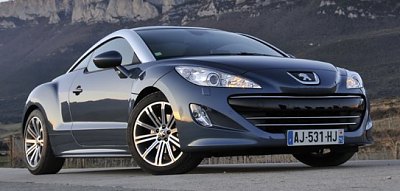
|
RCZ is the French response to Audi TT
|
When
Peugeot displayed the RCZ concept car in 2007 Frankfurt motor show, I
think not many people believed it would be put into production. You
know, in the past 30 years or so Peugeot built many radical concept
cars but never put one into production. While most other manufacturers
use concept cars to showcase new design theme or simply to preview the
next production models, Peugeot's concept cars are always decoupled
from the production side, strangely. They seemed to be created just for
the fun of motor show spectators. Having disappointed for so many
years, I didn't expect any exception for the RCZ concept.
To our surprise, two and a half years
later the production RCZ stands in front of us. Moreover, its exterior
and
interior design is virtually the same as the show car. This signals
a significant change in the product strategy of Peugeot. The dancing
lion used to
be rather conservative. Now in the attempt of migrating upmarket, it
needs more image-boosting models - certainly more than the lukewarm 407
Coupe. RCZ will be the first one. This car is the French response to
Audi TT. It is a very design-led product, or what people called
"hairdresser's car".
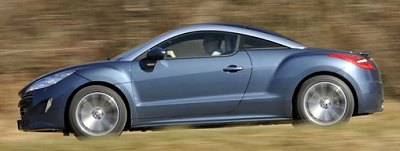
|
Visual impact is greater than Audi TT
|
Unquestionably, style is by far its greatest strength. Everything else
is less significant. The RCZ not only looks exactly like a concept car
happened on the road, its visual impact is, dare I say, greater than
that of Audi TT ! Not believe ? Look at that cab-forward and wide-track
proportion, that Zagato-style double-bubble roof and rear screen, those
brushed aluminum roof rails and that kick at each shoulder line. They
deliver a stronger message about style than the Audi masterpiece. Its
road presence is absolutely stunning.
Unfortunately, everything else is
rather ordinary. Take the dashboard for example, it comes straight from
308, although the center air-vent is replaced by an analogue clock,
oddly. It's an upmarket piece of work by the standard of hatchbacks,
but not quite in the
league of Audi TT, where you will find more stylish gauges and more
extensive use of real aluminum decors. Peugeot's version of
flat-bottomed steering wheel is not as tasteful as Audi's. Its seats
are not as classy too. One thing it does match the Audi: the tiny rear
seats are purely cosmetic. Head and legroom are barely enough for small
kids. For this reason, the Peugeot coupe will be compared with
2-seaters like BMW Z4, Mercedes SLK and Nissan 370Z, although its
closest rival is still Audi TT.
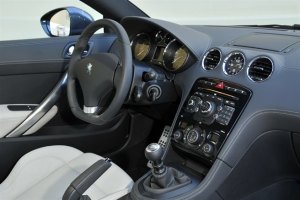
|
308-based cabin is so-so
|
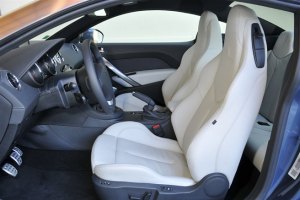 |
|
Price-wise,
the Peugeot coupe undercuts all the above rivals by considerable
margin. Its price starts from £20,000 and tops out at
£25,000, which is about the entry point of Audi TT. Mazda MX-5 is
the only cheaper alternative (at sub-£20,000), but it is no where
as substantial or as visually attractive. Peugeot found a sweet spot in
the marketplace.
However, the keen price comes from the simplicity of its mechanicals.
This coupe is built on the 308 platform. In other words, it is
front-wheel drive and rides on cheap suspensions consisting of
MacPherson struts up front and semi-independent torsion-beam at the
rear. To save the game, Peugeot lowers its ride height by 20mm, widens
its front and rear tracks by 54mm and 72mm respectively. Its center of
gravity is 40mm lower than the sportiest 308 hatchback, thanks to the
lowered roof, ride height and aluminum roof rails. Besides, the top
200hp model comes with an additional tower brace reinforcing the
front suspensions. Springs and dampers are considerably stiffer than
the regular 308's. Moreover, to improve steering feel, the electric
power steering is reverted to hydraulic one.
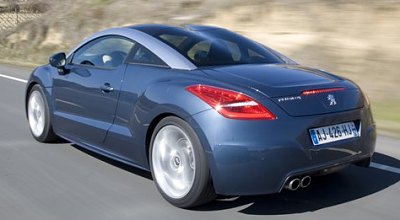
|
Rear spoiler raises at speed to reduce
lift
|
The TT-style body profile is likely to
generate a great deal of aerodynamic lift at speed, so Peugeot equipped
it with a pop-up rear spoiler, which adjusts its height between 2
positions depending on speed.
Engine range also comes from the modest 308. You have the choice of 3
engines: 156hp 1.6 DI turbo, 200hp high-pressure version of the same
engine and 163hp 2.0HDi turbo diesel. Even the 200hp engine cannot
propel the car much beyond 144 mph and 0-60 mph under 7.2
seconds. Such performance is definitely not as wild as its looks
suggested. In isolation, the BMW-sourced engine is not bad. It
displaces only 1.6 liters yet produces
200 horsepower. It differs from other versions of the BMW engine by
using variable valve timing on both intake and exhaust, and
"Valvetronic" variable intake valve lift simultaneously (previous
versions have intake VVT only and no Valvetronic). Its maximum torque
of 188 lb-ft can be lifted
momentarily to 203 lb-ft, thanks to an overboost up to 1.2 bar, to aid
overtaking. It
delivers power smoothly and linearly. Its exhaust sounds quite sporty
once you rev it to the upper half of rev range. However, owing to the
1300 kilograms it needs to haul, the 1.6 turbo engine feels exactly as
it is - a small engine squeezed to work on a large car. Floor down the
throttle, acceleration feels soft initially. It takes a moment to
gather rev and get into its sweet zone, which spans from 2200 to 6000
rpm, by then it feels reasonably punchy. You will enjoy the shift
quality and the closely stacked ratios of the 6-speed manual box.
Nevertheless, the powertrain combination is no match with Audi's
2.0TFSI engine and DSG gearbox.
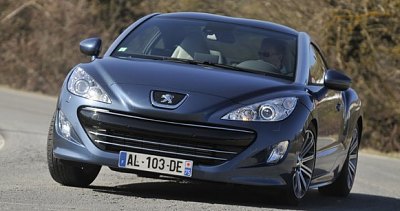 |
Power is modest; Handling feels more hot hatch than
sports car.
|
Because of its mechanical basis, the
RCZ drives more like a hot hatch than a thoroughbred sports car. Its
handling is neat, with plenty of grip from its 235/45 tires,
well-contained body roll and precise steering. Its balance is quite
neutral thanks to the endless front-end grip. However, it plays neither
power slide like a rear-drive sports car nor lift-off oversteer like
the old 205GTi. All it does is grip, grip and grip hard on the tarmac.
Ultimately, when it runs out of grip, it runs into terminal understeer
like most hot hatches – the nose-heavy diesel car is especially
obvious. Some may prefer such a precise and secured driving manner, but
driving enthusiasts will find it quite boring to drive. Regarding
ride quality, the RCZ feels firmly suspended. It's by no means
uncomfortable, but on rough surfaces the wide tires and
semi-independent suspension do transmit more shocks and noise into
the cabin than Audi TT, contributing to a less sophisticated impression.
We wish the RCZ could have had more firepower and more driver
interaction in its handling. However, this would have required to
develop a dedicated platform for the car, which means the keen prices
infeasible. By keeping its price in the range between £20,000 and
£25,000, the RCZ is safe from competition. It may lure many
buyers who put style over driving excitement. Peugeot believes it could
find 15,000 such customers every year. Production is to be
subcontracted to Magna-Steyr in
Austria. Peugeot had a good time of outsourcing production of 206CC,
which was
a runaway success. RCZ might be the same. |
Verdict:    |
Published on 10
Dec 2013
|
All rights reserved.
|
|
RCZ R
|
|
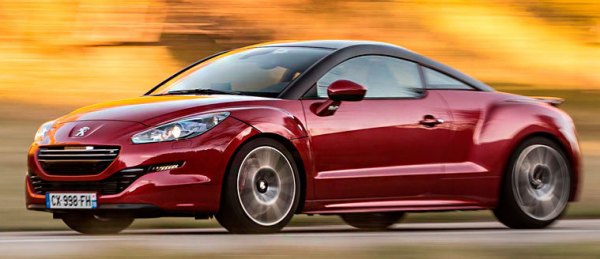
|
Stylish and affordable,
Peugeot RCZ has been seen as a low-cost alternative to Audi TT since
its introduction nearly 4 years ago. Earlier this year, it was given a
facelift (mainly a new corporate grille) to extend its lifespan, but
more important is a new range-topping performance model launched at the
year end. The RCZ R is developed with the help of Peugeot Sport, the
company's motorsport department. It has adopted many modifications to
enhance performance and handling. The aim is to transform the RCZ into
a real driver's car, something we declined to say to the regular car.
Can it succeed? Let's see what has been done…
Under the bonnet, the engine is still based on the BMW (Mini) 1.6-liter
DI turbo like the existing 200 hp model, but this version is identified
as EP6CDTR, where the last letter implies the racy treatment. Its
twin-scroll turbo is larger in order to produce higher (but
unspecified) boost pressure. This also necessitates the compression
ratio to be dropped from 10.0:1 to 9.2:1. Its forged aluminum pistons
are supplied by Mahle, being lighter and stiffer than the usual items,
and they are cooled by oil jets. Likewise, the Mahle connecting rods
are also designed to withstand higher load and rev. The exhaust
manifold is now made of lightweight stainless steel, which also
improves gas flow. The engine block is heat treated before machining to
improve strength. These modifications lift its output dramatically to
270 horsepower at 6000 rpm, making it the most powerful 1.6-liter
engine in production. I guess not even BMW could imagine what Peugeot
Sport has achieved. Moreover, the engine has lost little flexibility.
Turbo lag is surprisingly subtle, and its peak torque of 243 lbft is
available from 1900 to 5500 rpm.
On the road, this transforms the RCZ into a fast car finally. The small
engine feels pretty strong, but unlike some performance engines with
big turbo, its delivery is very linear and it is eager to rev until the
6800 rpm cut-out. The 0-60 mph time of 5.6 seconds is credible, but in
the cabin you would swear it must be quicker because the exhaust note
is so loud and sporty. It makes an Audi TT S tamed in comparison. The
clean and accurate gearshift also encourages you to use the rev range
to the full.
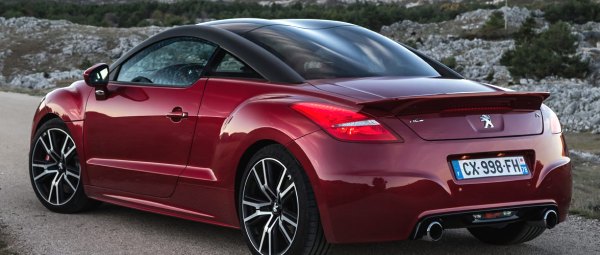
|
We don't have too much expectation on the 308-based
front-wheel-drive chassis, but once again the RCZ R is found to be
surprisingly good. Peugeot Sport retuned its springs, dampers,
anti-roll bars and suspension geometry. The front and rear are now 14
and 44 percent stiffer respectively. The ride height is dropped by 10
mm and tracks are widened a bit. Larger yet lighter 19-inch wheels are
shod with higher performance tires and accommodate larger brakes – the
front employs 380 mm discs and Alcon 4-pot calipers. Outside, a large
fixed rear spoiler reduces lift at high speed.
However, the most influential is the adoption of a Torsen LSD to the
front axle. Without it, the RCZ R would have been impossible to tame
its extra power. On the road, the LSD works brilliantly, limiting wheel
spin and reducing torque steer to merely gentle tugs in your hands even
on heavy throttle. It produces strong traction and keeps the nose
pointing to the right direction. The turn-in is sharp and accurate. The
steering feels heavier and more direct than the regular RCZ's. The body
control is superb. While the ride is firm, its damping is actually more
composed than the regular car. It feels as well controlled as a Renault
Megane RS 265, just lacking the latter's gifted talent of throttle
steer.
The Megane or a rear-drive Toyota 86 / Subaru BRZ is more entertaining
to drive, of course, but they can't quite match the Peugeot's style and
sense of occasion. Audi TT, BMW Z4 and Mercedes SLK are less fun to
drive. Among its rivals only Porsche Boxster/Cayman is clearly
superior, but this is also reflected on the price tag. RCZ R has found
the sweet spot.
|
Verdict:     |
|
|
|
|
|
|
|
|
|
|
RCZ 2.0HDi
|
2010
|
| Front-engined,
FWD |
| Steel monocoque |
| Mainly steel |
| 4287 / 1845 / 1359 mm |
| 2612 mm |
Inline-4, diesel
|
| 1997 cc |
DOHC 16 valves
|
VTG turbo
|
| CDI |
163 hp / 3750 rpm
|
251 lbft / 2000-3000 rpm
|
| 6-speed manual |
F: strut
R: torsion-beam
|
| - |
| 235/45R18 |
1370 kg
|
| 134 mph (c) |
8.2 (c)
|
| - |
|
RCZ 1.6THP (200hp)
|
2010
|
| Front-engined,
FWD |
| Steel monocoque |
| Mainly steel |
| 4287 / 1845 / 1359 mm |
| 2612 mm |
Inline-4
|
| 1598 cc |
DOHC 16 valves, DVVT, VVL
|
Turbo
|
| DI |
200 hp / 5800 rpm
|
188 lbft / 1700 rpm (overboost 203
lbft)
|
| 6-speed manual |
F: strut
R: torsion-beam
|
| - |
| 235/45R18 |
1297 kg
|
| 144 mph (c) |
7.2 (c)
|
| - |
|
RCZ R
|
2013
|
| Front-engined,
FWD |
| Steel monocoque |
| Mainly steel |
| 4294 / 1845 / 1352 mm |
| 2612 mm |
Inline-4
|
| 1598 cc |
DOHC 16 valves, DVVT, VVL
|
Turbo
|
| DI |
270 hp / 6000 rpm
|
243 lbft / 1900-5500 rpm
|
| 6-speed manual |
F: strut
R: torsion-beam
|
| - |
| 235/40ZR19 |
1280 kg
|
| 155 mph (limited) |
5.6 (c) / 5.9*
|
| 13.0* |
|
|
|
|
|
Performance
tested by: *Sport Auto
|
|
|
|
|
|
|
|
|
Copyright©
1997-2013
by Mark Wan @ AutoZine
|
|